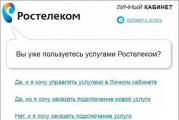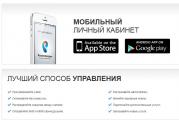What is a tariff plan. Tariff plans "Beeline"
Surely, when buying a starter package (SIM card) for your mobile phone, you have repeatedly come across the concept of “tariff plan”, choosing the terms of service from a particular operator. In this article, we will take a closer look at what it is, what is the advantage of working with ready-made plans, rather than individual options, and look at what plans different mobile operators have.
general characteristics
Let's start by describing what a tariff plan is. At the level of everyday communication, each of us understands that this is a certain set of conditions that implies a certain cost for certain services. If we are talking about a mobile communication plan, then this includes options such as calls (to numbers within the network or to subscribers of other mobile operators), SMS messages, some amount of data for working with mobile Internet, and so on. A certain set of all this is the “tariff plan”.
Each operator, in order to more conveniently orientate customers and, in addition, to manipulate the opinion of subscribers, gives certain names to their plans. For example, "Beeline" calls its tariff plans "All for ...", adding a number at the end of the name - the cost of the plan. Here there are tariffs “All for 200”, “All for 400” and so on. It is convenient, simple and concise - the subscriber understands that we are talking about the price of the plan, also realizing that he will be provided with a whole range of services (since “everything” is present). On a psychological level, I want to know what kind of tariff plan this is, and how profitable it can be.
So, for example, "All for 200" is free calls to numbers within the network in your region and in the Russian Federation, as well as SMS for 2 rubles. The cost of communication with subscribers of other operators is 9.9 rubles per minute. Again, the "All for 400" plan is already 2GB of Internet, 100 SMS, 400 free minutes. Further, Beeline's tariffs are increasing - for 600 rubles 600 minutes, 5GB and 300 SMS, for 900 - 1000 minutes, 6GB and 500 messages. The largest amount of opportunities is a plan for 1500 rubles. In it, the subscriber is provided with 10 GB of traffic, "unlimited" within the network, 1 thousand SMS.
This situation can be found in all mobile operators. For example, the tariff plans of Rostelecom (which serves Tele2) are creatively named. There are plans “Black”, “Very black”, “Blackest”, “Green”. It is not so easy to understand what exactly is meant by such names, but in general the idea is interesting, and subscribers may like it.
Plan Types

We explained a little about what a tariff plan is. Now we note that there are different types of tariffs, which can be divided based on different criteria. For example, many operators separate plans for subscribers on a contract basis from those served on a prepaid basis. Or else: there are Beeline tariff plans - within their framework, the user is given a certain amount of Internet traffic, they are posted on the company's website separately from the tariffs in which there is a range of services, since they are designed not only for phones.
Even in "Beeline" they share tariffs for prepaid and postpaid. For example, service on postpaid tariffs is somewhat different from the usual form of prepayment. Due to this, the company puts them in a separate group.
Some providers also separate tariffs with unlimited services (calls, SMS or traffic packages) from those where there is some kind of restriction.
Tariff examples

To make it easier, let's take some real plans in place for a particular company. At least the tariff plans of Rostelecom. "Cherny" makes it possible for 90 rubles a month to call for free to numbers within the network, and to other subscribers - 75 kopecks per minute (within their region). If we talk about communications throughout the country, then calls will cost 2 rubles / min - to Tele2 numbers and 9 rubles - to the rest. Also, the subscriber is given 1.5 GB of Internet.
"Blackest", as a more advanced tariff plan, provides a larger package of services. In particular, for 290 rubles per month, the user is given 4GB of Internet, 1000 free SMS, 100 minutes to other numbers throughout the country and 400 minutes to calls to subscribers of their network.
An interesting approach was taken to the process of creating options in the Ukrainian communications company Kyivstar. Tariff plans here are called: “For a smartphone”, “For a smartphone +”, “For calls” and so on. Thus, the subscriber, when making a choice, can simply navigate by the corresponding name of the service.
Some operators even have completely free promotional rates! For example, Beeline's "Internet Forever" plan is 200 megabytes of Internet for your tablet every month! Yes, this is really too small amount of data, but with it, any subscriber can test the connection speed for free.

How to choose?
By the way, this is also an interesting question - how, when ordering a new plan, make the right choice and subscribe to such a tariff that will completely suit you according to all criteria - in terms of cost, number of minutes for calls, Internet data package, and so on. Firstly, for this you will need to clearly understand how often you call, use the Internet, send messages. Secondly, you need to pay attention to the expediency of spending certain amounts of money on a monthly basis for servicing at a particular tariff. Thirdly, do not forget about special offers and various bonuses. They may also be present in the conditions of a particular tariff plan. When making a choice, do not forget about it - this way you can get some additional features that are not so obvious at first glance. Again, speaking of "Beeline", we can mention the action "Internet as a gift." If you purchase any branded device in their store (smartphone or tablet), they provide you with 10GB of Internet for 3 months as a gift. It seems that you don’t need to pay anything extra - and you will be provided with traffic!
How to know yours?
Given that this is obvious, in order to spend funds more efficiently, the subscriber needs to keep some kind of accounting for his expenses in order not to go beyond the volumes allocated to him. He can do this with the help of special commands or, for example, through his personal account. It's fast and accessible to everyone.
However, for this you need to understand how to find out your tariff plan. Since some users simply do not have information about the conditions under which they are served.
Again, there are some easy ways to find out your plan. The first is a call to the operator. On "Beeline" this number is 0611. The operator in the database will display information on the conditions under which your number works. The second is a check through the “Personal Account”. This is an affordable way for those who can get online. Again, Beeline has its own website, where there is a form for entering the office. Enter your personal data there - and you will see information about your plan. The third option is to check through your operator's communication salon. There you can apply as a subscriber and ask consultants to install your plan.

Switching to another tariff
Finally, having found out on what conditions you are provided with communication services, you can sort out a little with your expenses and with the options that are offered to you. For example, you can always upgrade to a better plan if you find one. Most of the time it's free, although sometimes there are certain fees for switching to another plan. It all depends on the policy of the operator and the conditions of a particular service.
We hope that the information in this article is laid out in such a way as to help you understand what a tariff plan is, how it works, and what its role is. As you understand, it is more convenient to work with it than with separate services, as it combines them and simplifies them. Moreover, plans, as a rule, are more profitable, since this is a package of services that, roughly speaking, the subscriber buys “wholesale”. Due to this, their price is lower
.




